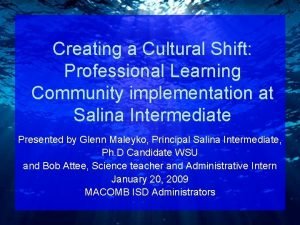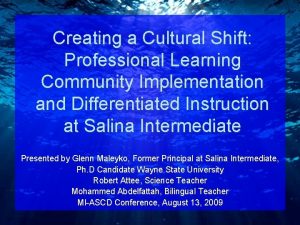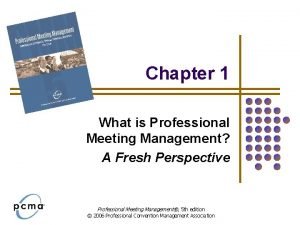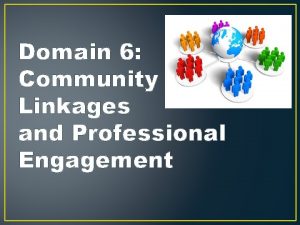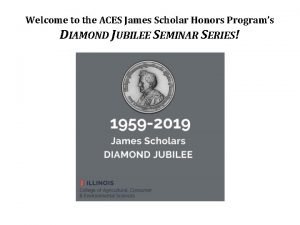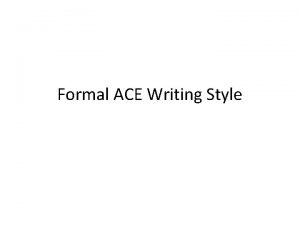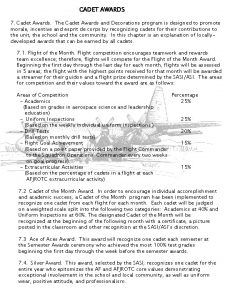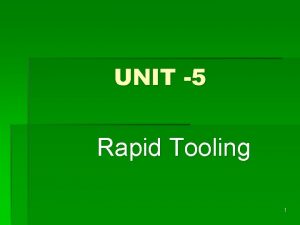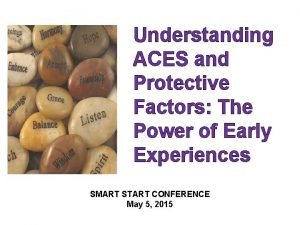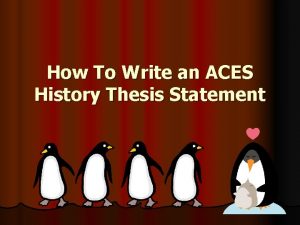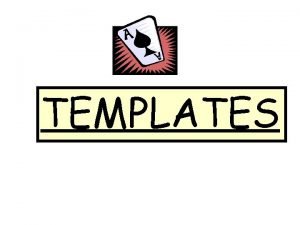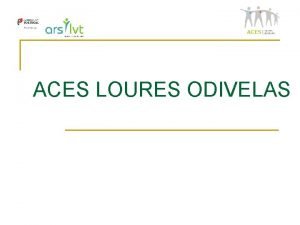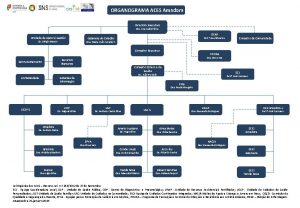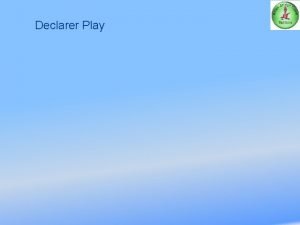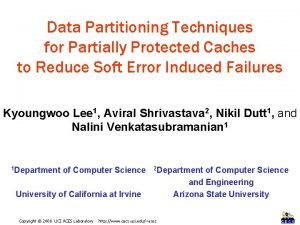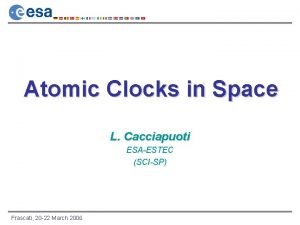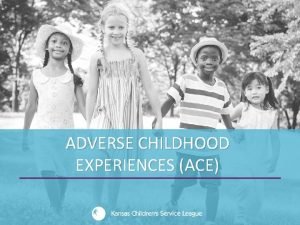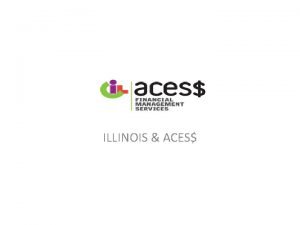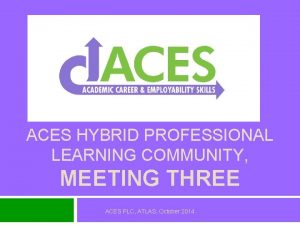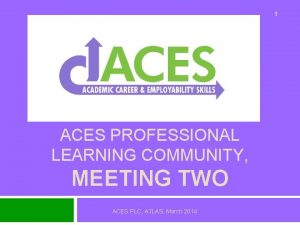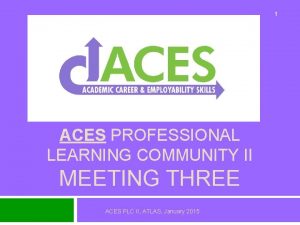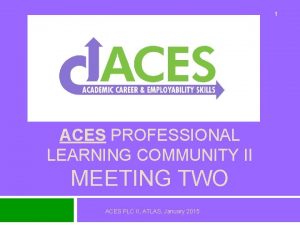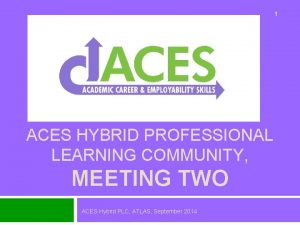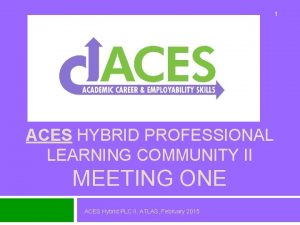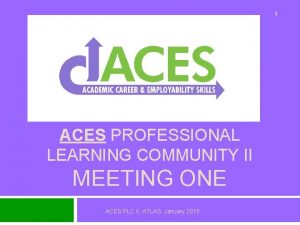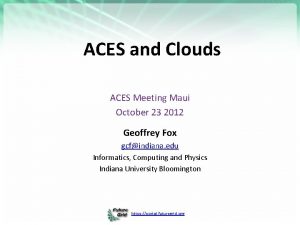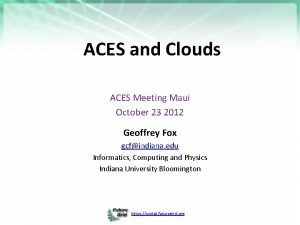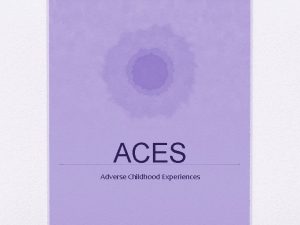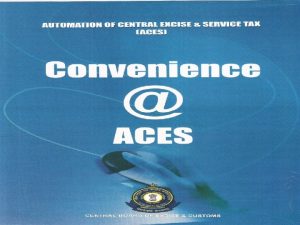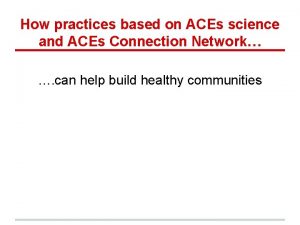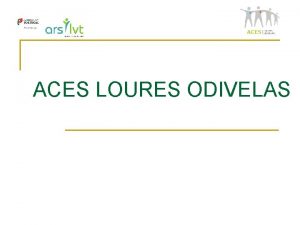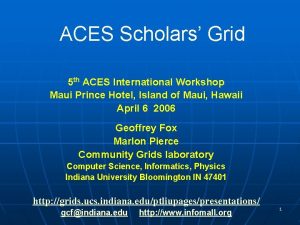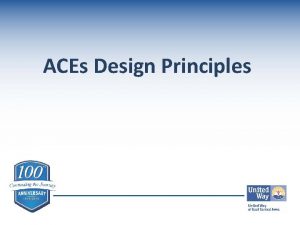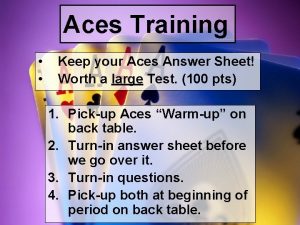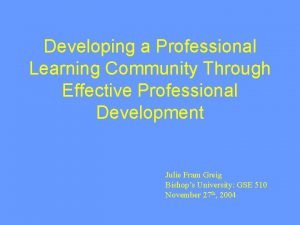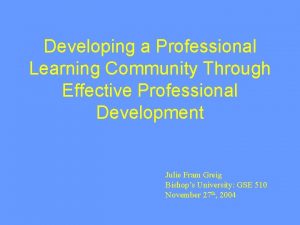1 ACES PROFESSIONAL LEARNING COMMUNITY MEETING THREE ACES























- Slides: 23

1 ACES PROFESSIONAL LEARNING COMMUNITY, MEETING THREE ACES PLC, ATLAS, March 2014

Meeting Three Agenda 2 Welcome back! Sharing our observations (Outside Task #5) Sharing our TIF-ed lessons (Outside Task #4) TIF-ing our classrooms (Outside Task #3) The Complete TIF Reflecting on this PLC What’s next? Self-reflection Wrap-up, questions, & plans to continue exploring transitions ACES PLC, ATLAS, March 2014

Warm-up Activity 3 Share of TIF “highlight” with the group. What is one positive outcome you had in your instructional setting that resulted from your PLC work? ACES PLC, ATLAS, March 2014

4 Who is the ideal ACES practitioner? The ideal ACES practitioner �knows about… �knows how to… �is committed to… What should we add to our list from last time? ACES PLC, ATLAS, March 2014

Lesson Observation through TIF Lens– Outside Task #5 5 Talk with a small group (NOT your working group). Discuss your Who/what did you observations of colleagues (or video observe? What transitions skills lesson). were put in action? What more “TIF-ing” could be done, do you ACES PLC, ATLAS, March 2014 think?

TIF-ed Lesson: Try it Out 2! – Outside Task #4 6 Now, in your working group, share your TIF -ed lesson/learner plan/materials. Discuss how you used the ACES process to assess, complement, Then share out some evaluate, and study & reflect a lesson for examples with the Outside Task #4. larger group. ACES PLC, ATLAS, March 2014

TIF Your Classroom! Outside Task #3 7 Write an example of a routine, norm, & learning task format that you did/do on each poster. ACES PLC, ATLAS, March 2014

Share some of your Norms/Routines/Learning Task Formats with the larger group 8 Share a few examples with the larger group. ACES PLC, ATLAS, March 2014

Break 9 ACES PLC, ATLAS, March 2014

Time for the Complete TIF Link: http: //atlasabe. org/professional/transitions 10 Navigate the complete TIF to find sample activities for the sub-skills in your category of focus. Transitions Integration Framework ACES PLC, ATLAS, March 2014

TIF Categories Effective Communication 11 Learning Strategies Academic Language & Skills Numeracy Critical Thinking Self-Management Developing a Future Pathway Navigating Systems ACES PLC, ATLAS, March 2014

12 TIF: Transitions Integration Framework Complete TIF contains: • • • Categories & definitions Skills & sub skills Sample activities ranging from simple to complex Sample technology ideas to practice skills Ideas to contextualize for community, school, or work Outlines the skills needed for successful transitions. Serves as a guide for integrating transition skills into instruction. Transitions Integration Framework ACES PLC, ATLAS, March 2014

Effective Communication (EC): Effective communication is a two-way process between individuals of diverse backgrounds and experience in which information is conveyed and received in ways that are mutually understood as intended. This can include speaking, writing, and all forms of nonverbal communication. Examples of activities in this category could include adjusting communication to suit various audiences, questioning to clarify meaning and to enhance understanding, or articulating differences and appreciating how differences can affect communication. Teaching the skills in this category will help the learner give and receive information in a purposeful, appropriate, and collaborative manner. Skill 1: SWBAT… Sub 13 Skills: Engage positively and actively with individuals in both one-on-one and team settings to accomplish goals a. Seek and offer clarification (clarifying questions, paraphrasing, restating)appropriately in spoken and written communications b. Repair communication breakdowns respectfully and effectively c. Acknowledge and affirm others (regardless of culture, religion, gender, age, sexual orientation) and their contributions d. Express expectations and acknowledge an understanding or acceptance of the expectations of others e. Participate, make contributions, and encourage the contributions of others in order to accomplish the shared goal of a team f. Employ effective strategies for resolving conflict EC: Skill 1 -Sub Skill a: Seek and offer clarification (clarifying questions, paraphrasing, restating) appropriately in spoken and written communications Complexity Role play basic scenarios* using rote Sample Activities phrases, posted in the classroom to request clarification (e. g. , Excuse me? Can you repeat that? ) and provide basic clarification as requested (e. g. , I said… I meant…). Role play scenarios* utilizing a variety of phrases, created by students and posted in the classroom, to request and offer clarification as requested. Discuss situations* in which asking for clarification is crucial. Discuss possible consequences that may result for not getting clarification. Write two contrasting scenarios; one with consequences for not requesting clarification, the other with better results after requesting clarification. Record phrases to request clarification (e. g. , Excuse me? Can you repeat that? ) using technology (e. g. , i. Pad, vocaroo. com, audacity). Listen to the phrases and evaluate accuracy and pronunciation (needs work, so-so, good). Record scenarios to request and offer Use email or online inquiry form to request clarification using technology (e. g. , i. Pad, clarification or to respond to requests for vocaroo. com, audacity). Listen to the clarification regarding contextualized topics. * scenarios and evaluate accuracy and pronunciation (needs improvement, so-so, good, excellent). * Grocery store, bank * Grocery store, library, bus stop * Banking information, billing issues School *Classroom * Questions regarding homework Work *Workplace * Paycheck error, clarifying instructions Technology Activities: Contexts Community ACES PLC, ATLAS, March 2014

The Complete TIF 14 Navigate the complete TIF to find sample activities for the sub-skills in your category of focus. Choose a sample activity you could tweak and use with your students. Discuss your choice with your partner/group. Transitions Integration Framework Then share out sample activity “finds” with the large group. How could this activity work in different contexts? ACES PLC, ATLAS, March 2014

Your TIF Category: How’s it going now? 15 Engaging positively and actively with individuals in both one-on-one and team settings to accomplish goals Setting realistic goals and working independently to achieve them Using information to draw conclusions and ACES PLC, ATLAS, March 2014 make decisions

Looking ahead…How often do you provide instruction that allows your students to… 16 Recognize and apply rich academic vocabulary in multiple discourses (reading, writing, speaking, and listening) Identify and follow norms of an organizational structure Evaluate personal skills, strengths, values, and beliefs to inform decisions about one’s future pathway ACES PLC, ATLAS, March 2014

Looking ahead…How often do you provide instruction that allows your students to… 17 Applying appropriate strategies for comprehending oral or written language in texts and listening activities Apply patterns and use variables to represent and solve problems that involve numeracy in everyday and/or academic contexts ACES PLC, ATLAS, March 2014

18 College & Career Readiness Standards (CCRS) Alignment TIF Abbreviations: Effective Communication (EF) Learning Strategies (LS) Academic Language and Skills (ALS) Numeracy (N) Critical Thinking (CT) CCRS Abbreviations: ELA/Literacy Domains Reading (R) Writing (W) Speaking and Listening (SL) Language (L) Mathematics Domains Domain abbreviation is followed by the Level (A-D) where the standard first appears. Numbers and Operations (NO) Operations and Algebraic Thinking (OAT) Geometry (G) Measurement and Data (MD) Ratios and Proportional Relationships (RP) Expressions and Equations (EE) Statistics and Probability Mathematical Practice (MP) ACES PLC, ATLAS, March 2014

TIF and CCRS Alignment Chart 19 Effective Communication EC. 1 a -- SL. 1 EC. 1 b -- SL. 1 EC. 1 e -- SL. 3 EC. 2 a -- SL. 5 EC. 2 b -- SL. 5 Critical Thinking CT. 1 d -- W. 1 CT. 3 -- R. 8 CT. 3 c -- W. 8 CT. 4 -- R. 8 CT. 4 a -- R. 6, SL. 3, W. 9 ACES PLC, ATLAS, March 2014

Where have we been? 20 Take some time to review our PLC activities. On the handout, identify the zoom-in and zoomout moments of our work and your main take-aways. ACES PLC, ATLAS, March 2014

What’s next? Think/Pair/Share 21 • What’s next? Choose which area(s) of the TIF you would like to explore next. • What local support would be helpful? • How can I impact my program? • What support will I need from the wider ABE community? ACES PLC, ATLAS, March 2014

SMART Goal Template (Optional!) 22 Discuss what SMART goals are, and set a SMART goal for continued application and learning of TIF integration. ACES PLC, ATLAS, March 2014

Thank you & Wrap-up 23 THANK YOU for participating in an ACES Professional Learning Community! ACES PLC, ATLAS, March 2014
 Cultural shifts in a professional learning community
Cultural shifts in a professional learning community Cultural shifts in a professional learning community
Cultural shifts in a professional learning community For today's meeting
For today's meeting Proposal kickoff meeting agenda
Proposal kickoff meeting agenda What is meeting and types of meeting
What is meeting and types of meeting Types of meeting
Types of meeting Cuadro comparativo de e-learning b-learning y m-learning
Cuadro comparativo de e-learning b-learning y m-learning Professional meeting management
Professional meeting management Domain 6: community linkages and professional engagement
Domain 6: community linkages and professional engagement Aces james scholar
Aces james scholar A.c.e writing examples
A.c.e writing examples To be recognized as an “ace of aces” a cadet must
To be recognized as an “ace of aces” a cadet must Aces paragraph format
Aces paragraph format Direct aim tooling
Direct aim tooling Aces protective factors
Aces protective factors How to write an aces paragraph
How to write an aces paragraph Aces writing rubric
Aces writing rubric Aces loures odivelas
Aces loures odivelas Aces amadora
Aces amadora Aces check cashing
Aces check cashing Aces
Aces Aces
Aces Aces
Aces Aces illinois
Aces illinois
